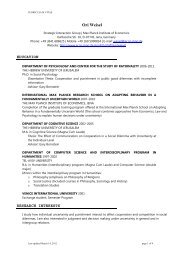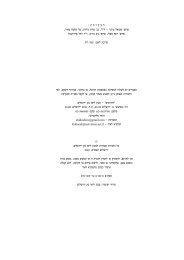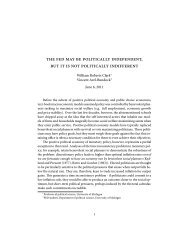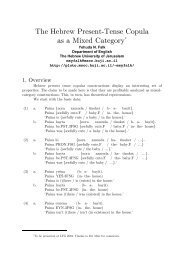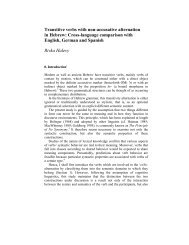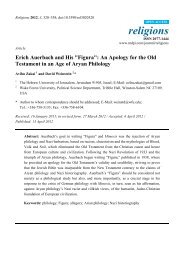Routine and the Perception of Time - Pluto Huji Ac Il
Routine and the Perception of Time - Pluto Huji Ac Il
Routine and the Perception of Time - Pluto Huji Ac Il
Create successful ePaper yourself
Turn your PDF publications into a flip-book with our unique Google optimized e-Paper software.
Journal <strong>of</strong> Experimental Psychology: General Copyright 2003 by <strong>the</strong> American Psychological Association, Inc.<br />
2003, Vol. 132, No. 4, 543–550 0096-3445/03/$12.00 DOI: 10.1037/0096-3445.132.4.543<br />
<strong>Routine</strong> <strong>and</strong> <strong>the</strong> <strong>Perception</strong> <strong>of</strong> <strong>Time</strong><br />
Dinah Avni-Babad <strong>and</strong> <strong>Il</strong>ana Ritov<br />
Hebrew University <strong>of</strong> Jerusalem<br />
The authors investigated <strong>the</strong> influence <strong>of</strong> routine on people’s estimation <strong>of</strong> time, testing <strong>the</strong> hypo<strong>the</strong>sis<br />
that duration is remembered as being shorter when time is spent in a routine activity. In 4 experiments<br />
<strong>and</strong> 2 field studies, <strong>the</strong> authors compared time estimations in routine <strong>and</strong> nonroutine conditions. <strong>Routine</strong><br />
was established by a sequence <strong>of</strong> markers (Study 1), variation <strong>of</strong> <strong>the</strong> task (Studies 2 <strong>and</strong> 3), or <strong>the</strong> number<br />
<strong>of</strong> repetitive blocks (Study 4). As hypo<strong>the</strong>sized, <strong>the</strong> duration <strong>of</strong> <strong>the</strong> task was remembered as being shorter<br />
in routine conditions than in nonroutine ones. This trend was reversed in experienced (prospective)<br />
judgments when participants were informed beforeh<strong>and</strong> <strong>of</strong> <strong>the</strong> duration-judgment task (Study 3). In<br />
Studies 5 <strong>and</strong> 6, <strong>the</strong> authors examined remembered duration judgments <strong>of</strong> vacationers <strong>and</strong> kibbutz<br />
members, which provided fur<strong>the</strong>r support for <strong>the</strong> main hypo<strong>the</strong>sis.<br />
The same space <strong>of</strong> time seems shorter as we grow older. . . . In youth<br />
we may have an absolutely new experience, subjective or objective,<br />
every hour <strong>of</strong> <strong>the</strong> day. Apprehension is vivid, retentiveness strong, <strong>and</strong><br />
our recollections <strong>of</strong> that time, like those <strong>of</strong> a time spent in rapid <strong>and</strong><br />
interesting travel, are <strong>of</strong> something intricate, multitudinous, <strong>and</strong> longdrawn-out.<br />
But as each passing year converts some <strong>of</strong> this experience<br />
into automatic routine which we hardly note at all, <strong>the</strong> days <strong>and</strong> <strong>the</strong><br />
weeks smooth <strong>the</strong>mselves out in recollection to contentless units, <strong>and</strong><br />
<strong>the</strong> years grow hollow <strong>and</strong> collapse. (James, 1890, p. 625)<br />
In this work, we examine <strong>the</strong> influence <strong>of</strong> routine on people’s<br />
estimations <strong>of</strong> time. A previous (unpublished) study found that<br />
people who routinely fly on planes felt safer <strong>and</strong> more secure <strong>and</strong><br />
reported swifter passage <strong>of</strong> time during flights than did people who<br />
fly less <strong>of</strong>ten (Avni-Babad, 2001). With <strong>the</strong> current investigation,<br />
we attempt to gain a better underst<strong>and</strong>ing <strong>of</strong> <strong>the</strong> power <strong>of</strong> routine<br />
<strong>and</strong> its influence on time perception.<br />
In research on time <strong>and</strong> duration judgments, a distinction is<br />
made between prospective <strong>and</strong> retrospective judgments. In prospective<br />
paradigms, <strong>the</strong> experimenter informs participants beforeh<strong>and</strong><br />
that <strong>the</strong>y will be asked to judge time duration. In retrospective<br />
paradigms, participants are not aware <strong>of</strong> <strong>the</strong> time-judging task,<br />
<strong>and</strong> <strong>the</strong>y are asked to judge event duration only after <strong>the</strong> time<br />
period has elapsed. Block (1978, 1989) called <strong>the</strong> first experienced<br />
duration <strong>and</strong> <strong>the</strong> second remembered duration. People tend to<br />
underestimate duration in prospective <strong>and</strong> retrospective judgments,<br />
but prospective judgments are longer than remembered judgments<br />
<strong>and</strong> <strong>the</strong>refore usually more accurate (Block & Zakay, 1997). The<br />
present work is focused mainly on retrospective estimations <strong>of</strong><br />
time.<br />
Dinah Avni-Babad <strong>and</strong> <strong>Il</strong>ana Ritov, School <strong>of</strong> Education, Hebrew University<br />
<strong>of</strong> Jerusalem, Jerusalem, Israel.<br />
We thank Richard Block, Elisha Babad, Robert Rosenthal, <strong>and</strong> Dan<br />
Zakay for <strong>the</strong>ir helpful comments <strong>and</strong> advice. We also thank Rob Hartsuiker<br />
<strong>and</strong> Helen Buckl<strong>and</strong> <strong>of</strong> <strong>the</strong> University <strong>of</strong> Edinburgh; Arik Tayeb,<br />
Tehila Kogut, <strong>and</strong> Anat Mehbar <strong>of</strong> Hebrew University <strong>of</strong> Jerusalem; <strong>and</strong><br />
Nancy Simon for <strong>the</strong>ir assistance.<br />
Correspondence concerning this article should be addressed to Dinah<br />
Avni-Babad, School <strong>of</strong> Education, Hebrew University <strong>of</strong> Jerusalem, Mount<br />
Scopus, Jerusalem 91905, Israel. E-mail: avni@mscc.huji.ac.il<br />
543<br />
Evidence shows that people perceive inaction as normal <strong>and</strong><br />
action as abnormal (Kahneman & Miller, 1986; L<strong>and</strong>man, 1987).<br />
<strong>Ac</strong>tions are regretted more than inaction (Gleicher et al., 1990;<br />
Kahneman & Tversky, 1982; Ritov & Baron, 1995) in <strong>the</strong> short<br />
term <strong>and</strong> <strong>the</strong> long term (Byrne & McEleney, 2000), even when<br />
people do not know <strong>the</strong> counterfactual alternative to <strong>the</strong>ir action or<br />
<strong>the</strong>ir failure to act (Avni-Babad, 2003). It is unlikely that people<br />
would regret an act committed on a routine basis because routines<br />
are people’s normal activities. Thus, even though a routine day <strong>of</strong><br />
work might have been very busy, people may think that <strong>the</strong>y did<br />
not do much <strong>and</strong> time flew. Most people are familiar with <strong>the</strong><br />
experience <strong>of</strong> thinking, after looking at <strong>the</strong>ir watch at <strong>the</strong> end <strong>of</strong> <strong>the</strong><br />
routine day, that time passed <strong>and</strong> <strong>the</strong>y do not know where it went.<br />
The remembered duration <strong>of</strong> a time period is not simply a<br />
reflection <strong>of</strong> its actual duration. Early models proposed that retrospective<br />
evaluation is based on retrieval <strong>of</strong> information from<br />
long-term memory (Ornstein, 1969). Events that occurred during<br />
<strong>the</strong> remembered period serve as markers for reconstructing duration:<br />
<strong>the</strong> more events remembered, <strong>the</strong> longer <strong>the</strong> judged duration.<br />
However, <strong>the</strong> storage-size model did not account for data showing<br />
discrepancies between content memory <strong>and</strong> evaluated duration<br />
(Block & Reed, 1978). It appeared that <strong>the</strong> most important factor<br />
in assessing duration was not just <strong>the</strong> number <strong>of</strong> recalled events but<br />
<strong>the</strong> extent to which those events constituted a contextual change<br />
(Block, 1985).<br />
This is consistent with James’s (1890) statement that “awareness<br />
<strong>of</strong> change is thus <strong>the</strong> condition on which our perception <strong>of</strong><br />
time’s flow depends” (p. 620) <strong>and</strong> with Fraisse’s (1963) claim that<br />
“psychological duration is composed <strong>of</strong> psychological changes”<br />
(p. 216). Cognitive research on <strong>the</strong> psychology <strong>of</strong> time showed that<br />
changes introduced during a time period influenced its remembered<br />
duration (Block & Reed, 1978). <strong>Time</strong> duration seemed<br />
longer when subjects used different kinds <strong>of</strong> cognitive processes.<br />
The contextual change hypo<strong>the</strong>sis was fur<strong>the</strong>r supported by<br />
Poynter’s work on segmentation (Poynter, 1983). Poynter showed<br />
that events that are used as segmentation markers serve as scaffolding<br />
for reconstructing duration. He found that <strong>the</strong> time it took<br />
to go through a word list was remembered as being longer when<br />
markers were distributed throughout <strong>the</strong> list than when <strong>the</strong> same<br />
markers were clustered toge<strong>the</strong>r. Zakay, Tsal, Moses, <strong>and</strong> Shahar
544<br />
(1994) used <strong>the</strong> names <strong>of</strong> politicians as markers <strong>and</strong> inserted <strong>the</strong>m<br />
in a list <strong>of</strong> nouns. The markers were called high-priority events<br />
(HPEs). Zakay et al. replicated Poynter’s findings, showing a<br />
positive relationship between segmentation level <strong>and</strong> estimated<br />
duration, although segmentation did not significantly affect overall<br />
memory. Thus, it appears that <strong>the</strong> impact <strong>of</strong> segmentation on<br />
retrospective duration estimation is mostly due to its role in creating<br />
contextual changes within <strong>the</strong> evaluated interval.<br />
Webster’s New Collegiate Dictionary (1980) defines routine as<br />
“habitual or mechanical performance <strong>of</strong> an established procedure”<br />
(p. 509). The essence <strong>of</strong> a routine is its repetitive pattern <strong>of</strong> highly<br />
predictable actions <strong>and</strong> events. This implies diminished salience <strong>of</strong><br />
<strong>the</strong> various objects, actions, <strong>and</strong> events that make up an established<br />
routine. Thus, contextual change (in <strong>the</strong> sense used by Block,<br />
1985) is unlikely to occur in <strong>the</strong> midst <strong>of</strong> a routine. In contrast,<br />
unexpected or nonroutine occurrences are likely to attract attention<br />
when <strong>the</strong>y occur, give rise to contextual change, <strong>and</strong> be relatively<br />
memorable (Ritov, 2000). It follows that retrospective estimates <strong>of</strong><br />
<strong>the</strong> duration <strong>of</strong> nonroutine periods should tend to be longer than<br />
retrospective estimates <strong>of</strong> <strong>the</strong> duration <strong>of</strong> routine periods.<br />
In <strong>the</strong> first experiment, we followed procedures used by Zakay<br />
et al. (1994) to investigate segmentation processes, but <strong>the</strong> segments<br />
were set up into a routine order. In <strong>the</strong> second experiment,<br />
we controlled for <strong>the</strong> number <strong>of</strong> segments but varied <strong>the</strong> degree <strong>of</strong><br />
contextual change between segments. In a third experiment, we<br />
compared prospective <strong>and</strong> retrospective duration estimations <strong>of</strong><br />
routine <strong>and</strong> nonroutine equal-length experiences. With <strong>the</strong> fourth<br />
<strong>and</strong> fifth studies, we examined <strong>the</strong> positive time-order error as a<br />
characteristic <strong>of</strong> routine. The positive time-order error is <strong>the</strong> finding<br />
that people remember <strong>the</strong> first <strong>of</strong> two equal periods as being<br />
longer than <strong>the</strong> second. The contextual change model proposes that<br />
subjects encode more changes during a new experience <strong>and</strong> this<br />
leng<strong>the</strong>ns remembered duration (Block, 1985). The positive timeorder<br />
error was examined in <strong>the</strong> fourth study as a characteristic <strong>of</strong><br />
a routine’s evolution in a lab experiment, in which participants<br />
watched teachers’ video clips in three parts <strong>and</strong> became familiar<br />
with <strong>the</strong> procedures. They were consequently asked about <strong>the</strong><br />
remembered comparative duration <strong>of</strong> <strong>the</strong> parts <strong>and</strong> <strong>the</strong>ir interest in<br />
<strong>the</strong>m. Participants’ memory <strong>of</strong> <strong>the</strong> different parts was measured as<br />
well. The fifth study was conducted at a vacation resort <strong>and</strong> tested<br />
<strong>the</strong> idea that time is remembered as having passed faster as people<br />
became involved in <strong>the</strong>ir vacation routine. Vacationers were asked<br />
to judge <strong>the</strong> duration <strong>of</strong> time passage at <strong>the</strong> beginning, middle, <strong>and</strong><br />
end <strong>of</strong> <strong>the</strong>ir vacation. In <strong>the</strong> sixth study, kibbutz members were<br />
interviewed about <strong>the</strong>ir retrospective judgment <strong>of</strong> time at <strong>the</strong>ir<br />
regular routine job versus nonroutine jobs.<br />
Experimental Studies<br />
Study 1: <strong>Routine</strong> Segments<br />
This experiment was designed to test <strong>the</strong> hypo<strong>the</strong>sis that increasing<br />
<strong>the</strong> number <strong>of</strong> markers (HPEs) that create segments<br />
would not result in more perceived changes if <strong>the</strong>y were presented<br />
in a routine sequence. A routine sequence maintains a rhythmical<br />
pattern that may ameliorate <strong>the</strong> effect <strong>of</strong> <strong>the</strong> HPEs as markers that<br />
create contextual changes. As Poynter (1989) pointed out, “Not<br />
only <strong>the</strong> number <strong>of</strong> events in an interval, but also <strong>the</strong> degree <strong>of</strong><br />
contextual change each event produces should affect perceived<br />
AVNI-BABAD AND RITOV<br />
duration” (p. 309). Therefore, it was expected that in <strong>the</strong> highsegmentation–routine<br />
condition, time duration would be judged to<br />
be shorter than in <strong>the</strong> low-segmentation conditions <strong>and</strong> also shorter<br />
than in <strong>the</strong> high-segmentation–nonroutine condition.<br />
Method<br />
Participants. Participants were four groups <strong>of</strong> undergraduate students<br />
(with 35, 28, 32, <strong>and</strong> 45 students in each group, for a total <strong>of</strong> 140) who took<br />
part in a memory experiment for credit in a psychology course. All groups<br />
were run in parallel sessions during a single week.<br />
Materials <strong>and</strong> procedure. Four tapes were prepared with two recordings<br />
on each. The first recording was identical in <strong>the</strong> four tapes. It consisted<br />
<strong>of</strong> a 15-s silent interval starting with <strong>the</strong> word “start” <strong>and</strong> ending with <strong>the</strong><br />
word “end.” The second recording, 60 s in length, contained a list <strong>of</strong> 20<br />
Hebrew nouns <strong>and</strong> <strong>the</strong> last names <strong>of</strong> 10 Israeli politicians (<strong>the</strong> HPEs). The<br />
list was read aloud in a monotonous voice. The duration <strong>of</strong> each word was<br />
approximately 1 s <strong>and</strong> <strong>the</strong> pause between <strong>the</strong> words was also 1 s long.<br />
On <strong>the</strong> first tape (high-segmentation–routine condition), <strong>the</strong> HPEs were<br />
spread evenly among <strong>the</strong> nouns (in Positions 3, 6, 9, etc.). On <strong>the</strong> second<br />
tape (low-segmentation–HPEs-last condition), <strong>the</strong> 20 nouns were read first,<br />
<strong>the</strong>n <strong>the</strong> HPEs were read in <strong>the</strong> same monotone voice. On <strong>the</strong> third tape (<strong>the</strong><br />
low-segmentation–HPEs-first condition), <strong>the</strong> HPEs were read first, followed<br />
by <strong>the</strong> 20 nouns. On <strong>the</strong> fourth tape (<strong>the</strong> high-segmentation–<br />
nonroutine condition), <strong>the</strong> HPEs were spread in a nonroutine way (as<br />
determined by two judges) amongst <strong>the</strong> nouns, in Positions 2, 3, 4, 8, 10,<br />
12, 18, 19, 23, <strong>and</strong> 29.<br />
The experiment was presented as a memory task. Participants were told<br />
that <strong>the</strong>y would hear a silent interval starting with <strong>the</strong> word “start” <strong>and</strong><br />
ending with <strong>the</strong> word “end,” followed by a list <strong>of</strong> nouns <strong>and</strong> politicians’<br />
names. They were asked to remember as many words as <strong>the</strong>y could <strong>and</strong> to<br />
pay special attention to <strong>the</strong> politicians’ names. After listening to <strong>the</strong> tape,<br />
participants were asked to estimate <strong>the</strong> length <strong>of</strong> <strong>the</strong> tape containing <strong>the</strong> list<br />
<strong>of</strong> words (nouns <strong>and</strong> HPEs).<br />
The perceived duration <strong>of</strong> <strong>the</strong> second tape was measured by a comparative<br />
estimation method: Participants were given a page with two horizontal<br />
lines that started from a common left-h<strong>and</strong> margin. The upper line was<br />
short <strong>and</strong> represented <strong>the</strong> silent interval. The bottom line continued to <strong>the</strong><br />
right-h<strong>and</strong> end margin <strong>of</strong> <strong>the</strong> page, <strong>and</strong> participants were asked to mark<br />
<strong>the</strong>ir evaluation <strong>of</strong> <strong>the</strong> recorded tape length in comparison to <strong>the</strong> silent<br />
interval. As in Zakay et al.’s (1994) study, <strong>the</strong> participants were <strong>the</strong>n asked<br />
to report <strong>the</strong>ir estimate <strong>of</strong> <strong>the</strong> overall number <strong>of</strong> words in <strong>the</strong> list (<strong>the</strong><br />
recalled number <strong>of</strong> events). This measure was used to examine <strong>the</strong> relationship<br />
between time estimation <strong>and</strong> <strong>the</strong> remembered number <strong>of</strong> stimuli<br />
separately from <strong>the</strong> specific retrieval <strong>of</strong> words from memory. After making<br />
an overall estimate <strong>of</strong> <strong>the</strong> number <strong>of</strong> words, participants were asked to<br />
recall as many words as possible from <strong>the</strong> list <strong>of</strong> nouns <strong>and</strong> HPEs (as did<br />
Zakay et al., 1994, with some <strong>of</strong> <strong>the</strong>ir subjects).<br />
Results <strong>and</strong> Discussion<br />
As expected, participants in <strong>the</strong> high-segmentation–routine condition<br />
remembered <strong>the</strong> duration <strong>of</strong> <strong>the</strong> second tape as being shorter<br />
than did <strong>the</strong> participants in all o<strong>the</strong>r conditions. The mean duration<br />
estimates were represented by lines averaging 83.27 mm (SD <br />
36.17) for <strong>the</strong> high-segmentation–routine condition, 104.96 mm<br />
(SD 42.86) for <strong>the</strong> low-segmentation–HPEs-last condition,<br />
104.88 mm (SD 43.00) for <strong>the</strong> low-segmentation–HPEs-first<br />
condition, <strong>and</strong> 118.11 mm (SD 31.28) for <strong>the</strong> highsegmentation–nonroutine<br />
condition. The one-way analysis <strong>of</strong> variance<br />
(ANOVA) yielded a significant effect, F(3, 134) 5.40,<br />
MSE 1,431.79, p .005, 2 .108. Post hoc contrasts indicated<br />
that <strong>the</strong> mean <strong>of</strong> <strong>the</strong> high-segmentation–routine condition
was smaller than <strong>the</strong> mean <strong>of</strong> <strong>the</strong> high-segmentation–nonroutine<br />
condition, F(1, 134) 16.14, p .001, 2 .107, <strong>and</strong> also that<br />
<strong>the</strong> mean for <strong>the</strong> high-segmentation–routine condition was smaller<br />
than <strong>the</strong> means <strong>of</strong> <strong>the</strong> o<strong>the</strong>r three conditions, F(1, 134) 11.78,<br />
p .001, 2 .081.<br />
Free recall <strong>of</strong> politicians’ names also yielded a significant difference.<br />
Participants in all conditions o<strong>the</strong>r than <strong>the</strong> highsegmentation–routine<br />
condition recalled more politicians’ names<br />
than did participants in <strong>the</strong> high-segmentation–routine condition.<br />
The mean numbers <strong>of</strong> HPEs recalled (out <strong>of</strong> 10 politician names)<br />
were 6.07 (SD 1.78) for <strong>the</strong> low-segmentation–HPEs-last condition,<br />
5.69 (SD 1.45) for <strong>the</strong> low-segmentation–HPEs-first<br />
condition, 5.87 (SD 1.79) for <strong>the</strong> high-segmentation–nonroutine<br />
condition, <strong>and</strong> 4.51 (SD 1.74) for <strong>the</strong> high-segmentation–routine<br />
condition, F(3, 136) 5.77, MSE 2.902, p .001, 2 .113.<br />
Post hoc contrasts showed again that <strong>the</strong> mean <strong>of</strong> <strong>the</strong> highsegmentation–routine<br />
condition was smaller than <strong>the</strong> mean <strong>of</strong> <strong>the</strong><br />
high-segmentation–nonroutine condition, F(1, 136) 12.41, p <br />
.001, 2 .084, <strong>and</strong> that <strong>the</strong> mean <strong>of</strong> <strong>the</strong> high-segmentation–<br />
routine condition was smaller than <strong>the</strong> means <strong>of</strong> <strong>the</strong> o<strong>the</strong>r three<br />
conditions, F(1, 134) 16.58, p .001, 2 .109.<br />
Because <strong>the</strong> high-segmentation–nonroutine condition included<br />
more HPEs in <strong>the</strong> primacy portion, which might account for <strong>the</strong><br />
difference in recall, we fur<strong>the</strong>r compared <strong>the</strong> recall <strong>of</strong> HPEs in <strong>the</strong><br />
routine <strong>and</strong> nonroutine high-segmentation conditions while omitting<br />
<strong>the</strong> first 3 HPEs on <strong>the</strong> list (out <strong>of</strong> 10). The participants in <strong>the</strong><br />
nonroutine condition recalled significantly more HPEs (M 3.64,<br />
SD 1.52) than did <strong>the</strong> participants in <strong>the</strong> routine condition (M <br />
2.78, SD 1.39), t(71) 2.41, p .05. 1 No significant difference<br />
was found for <strong>the</strong> estimations <strong>of</strong> overall number <strong>of</strong> words (all Fs <br />
0.15, all ps .8) or for <strong>the</strong> number <strong>of</strong> nouns recalled (all Fs 1.5,<br />
all ps .25), indicating that participants had indeed concentrated<br />
on <strong>the</strong> HPEs, <strong>and</strong> those functioned as markers that were later<br />
retrieved from memory.<br />
Thus, <strong>the</strong> even sequence <strong>of</strong> a high number <strong>of</strong> segments probably<br />
created <strong>the</strong> sense <strong>of</strong> automatism that characterizes routine. The<br />
repetitiveness <strong>of</strong> <strong>the</strong> markers might have influenced <strong>the</strong> participants<br />
to perceive duration as shorter in <strong>the</strong> high-segmentation–<br />
routine condition than in <strong>the</strong> o<strong>the</strong>r three conditions.<br />
The routine sequence also might have hindered <strong>the</strong> memory <strong>of</strong><br />
<strong>the</strong> markers, which were remembered less well in <strong>the</strong> highsegmentation–routine<br />
condition. The better memory <strong>of</strong> <strong>the</strong> HPEs<br />
in <strong>the</strong> low-segmentation conditions could also be due to <strong>the</strong>ir being<br />
read last or first, adding a potential recency <strong>and</strong> primacy effect, but<br />
<strong>the</strong> difference in memory between <strong>the</strong> high-segmentation conditions<br />
can only be explained by <strong>the</strong> routine order. Consequently, in<br />
<strong>the</strong> high-segmentation–routine condition, memory was poor <strong>and</strong><br />
time estimations were shorter.<br />
In past research on retrospective time estimations, a higher level<br />
<strong>of</strong> segmentation led to longer judgments <strong>of</strong> duration (Poynter,<br />
1983; Poynter & Homa, 1983; Zakay & Feldman, 1993). Block<br />
(1978, 1989) related duration estimates with <strong>the</strong> number <strong>of</strong><br />
changes. In <strong>the</strong>ir contextual change model, Block <strong>and</strong> Reed (1978)<br />
suggested that varying <strong>the</strong> levels <strong>of</strong> processing context increases<br />
<strong>the</strong> time judgments <strong>of</strong> <strong>the</strong> interval. These contextual changes<br />
apparently do not occur when <strong>the</strong> number <strong>of</strong> changes increases if<br />
<strong>the</strong>y are part <strong>of</strong> a repetitive routine. It is suggested that when<br />
changes become routinized, <strong>the</strong>y do not operate as changes anymore;<br />
ra<strong>the</strong>r, <strong>the</strong> opposite effect occurs. Perhaps people do not<br />
ROUTINE AND THE PERCEPTION OF TIME<br />
perceive <strong>the</strong>m as changes because <strong>of</strong> <strong>the</strong>ir predictable nature, <strong>and</strong><br />
<strong>the</strong>refore, in <strong>the</strong> last experiment, <strong>the</strong> politicians’ names may have<br />
been stored in memory in a ra<strong>the</strong>r shallow way. Thus, people<br />
remembered durations as being shorter <strong>and</strong> <strong>the</strong> HPEs were remembered<br />
less.<br />
In <strong>the</strong> next two experiments, we investigated whe<strong>the</strong>r a routine<br />
task would result in shorter time estimations than nonroutine<br />
(changing) tasks. In both experiments, we kept <strong>the</strong> number <strong>of</strong><br />
segments equal, consequently isolating <strong>the</strong> influence <strong>of</strong> <strong>the</strong> routine<br />
or nonroutine task. The nonroutine task we used was very similar<br />
to <strong>the</strong> routine one, thus ensuring that <strong>the</strong> tasks would not differ<br />
significantly in complexity.<br />
Method<br />
Study 2: <strong>Routine</strong> <strong>and</strong> Nonroutine Tasks<br />
545<br />
Participants. Thirty-eight male <strong>and</strong> female undergraduate students, 19<br />
to 25 years <strong>of</strong> age, participated for credit in a psychology course. They<br />
were r<strong>and</strong>omly assigned to ei<strong>the</strong>r <strong>the</strong> routine condition or <strong>the</strong> nonroutine<br />
condition (n 19 in each condition).<br />
Materials <strong>and</strong> procedure. The experiment was presented as a memory<br />
task. Participants were given a list with 20 rows <strong>of</strong> numbers. Each row<br />
consisted <strong>of</strong> 38 digits from 0 to 9, which appeared r<strong>and</strong>omly. The lists <strong>of</strong><br />
digits, except for underlining, were identical in both conditions. Each row<br />
ended with a blank space to be filled in so that each row constituted a<br />
segment. The number <strong>of</strong> rows or segments was identical for both conditions.<br />
Early in each segment (but not necessarily in <strong>the</strong> first place), one<br />
digit was underlined. Participants were asked to count <strong>the</strong> number <strong>of</strong> times<br />
<strong>the</strong> underlined digit appeared in <strong>the</strong> segment <strong>and</strong> to write <strong>the</strong>ir answer at<br />
<strong>the</strong> end, in <strong>the</strong> blank space. In <strong>the</strong> routine condition, <strong>the</strong> underlined digit<br />
was always 5. In <strong>the</strong> nonroutine condition, <strong>the</strong> underlined digit was<br />
different in each segment, but <strong>the</strong> number <strong>of</strong> times it appeared was identical<br />
to <strong>the</strong> number <strong>of</strong> times <strong>the</strong> digit 5 appeared in that same row <strong>of</strong> <strong>the</strong> routine<br />
condition. For instance, if <strong>the</strong> digit 8 was underlined in <strong>the</strong> 10th segment<br />
<strong>of</strong> <strong>the</strong> nonroutine condition <strong>and</strong> appeared six times in that segment, number<br />
5 would be underlined in <strong>the</strong> 10th segment in <strong>the</strong> routine condition, <strong>and</strong> it<br />
would also appear six times. In that way, <strong>the</strong> two tasks differed in <strong>the</strong>ir<br />
routine nature but did not differ in complexity. Both were very simple<br />
tasks, <strong>and</strong> counting <strong>the</strong> number <strong>of</strong> times 5 appeared in a segment was as<br />
simple as counting <strong>the</strong> number <strong>of</strong> times <strong>the</strong> digit 8 appeared in its equivalent<br />
segment.<br />
The task was explained to <strong>the</strong> participants by an experimenter, who <strong>the</strong>n<br />
completed <strong>the</strong> first row <strong>of</strong> numbers as an example. They were <strong>the</strong>n told that<br />
<strong>the</strong>y would be given time to practice in <strong>the</strong> next two segments (described<br />
as “practice time”) <strong>and</strong> were asked to start when <strong>the</strong>y heard <strong>the</strong> word<br />
“start” <strong>and</strong> to stop when <strong>the</strong>y heard <strong>the</strong> word “stop.” The time given for <strong>the</strong><br />
practice phase in those two segments was 20 s. After that, <strong>the</strong>y were asked<br />
to move on to <strong>the</strong> experiment itself <strong>and</strong> to begin counting again (for <strong>the</strong> 17<br />
segments that were left) when <strong>the</strong>y heard <strong>the</strong> word “start” <strong>and</strong> to stop when<br />
<strong>the</strong>y heard <strong>the</strong> word “stop.” The time assigned for <strong>the</strong> experimental part<br />
was 120 s. After <strong>the</strong> 2 min, participants were asked to estimate <strong>the</strong> time <strong>of</strong><br />
<strong>the</strong> experimental part, as in Study 1, by marking a line in comparison to a<br />
given short line that represented <strong>the</strong> practice time (20 s). The line that<br />
participants marked was later measured in millimeters <strong>and</strong> served as <strong>the</strong><br />
dependent variable representing time estimation.<br />
Results <strong>and</strong> Discussion<br />
As predicted, participants in <strong>the</strong> nonroutine condition made<br />
longer retrospective estimations <strong>of</strong> time (M 168.10 mm, SD <br />
1<br />
We are grateful to an anonymous reviewer who raised this potential<br />
confound.
546<br />
44.80) than did participants in <strong>the</strong> routine condition (M 128.89<br />
mm, SD 29.62). The difference between <strong>the</strong> means <strong>of</strong> <strong>the</strong><br />
routine <strong>and</strong> nonroutine conditions was statistically significant,<br />
t(36) 3.18, p .01, 2 .22.<br />
The groups performed <strong>the</strong> same kind <strong>of</strong> task in both conditions.<br />
The number <strong>of</strong> segments was equal; only <strong>the</strong> nature <strong>of</strong> <strong>the</strong> task—<br />
routine versus nonroutine—was different. Thus, <strong>the</strong> results indicate<br />
that retrospective duration estimation was affected by routine,<br />
even when <strong>the</strong> number <strong>of</strong> segments was kept constant. Presumably,<br />
<strong>the</strong> contextual change occurring at <strong>the</strong> beginning <strong>of</strong> each<br />
segment in <strong>the</strong> nonroutine task increased <strong>the</strong> salience <strong>of</strong> <strong>the</strong> segmentation.<br />
The hypo<strong>the</strong>sis that routine would result in a shorter<br />
time estimation than would nonroutine was confirmed.<br />
Study 3: Prospective <strong>and</strong> Retrospective <strong>Time</strong> Estimations<br />
in <strong>Routine</strong> <strong>and</strong> Nonroutine Tasks<br />
Wood, Quinn, <strong>and</strong> Kashy (2002), in two recent diary studies,<br />
showed that when participants were engaged in habitual behavior,<br />
<strong>the</strong>ir thoughts drifted to issues unrelated to <strong>the</strong> behavior. When<br />
<strong>the</strong>y were involved in nonhabitual behavior, participants’ thoughts<br />
corresponded to <strong>the</strong>ir behavior. The authors suggested that thought<br />
is necessary to guide a nonhabitual action but is less necessary<br />
when one is performing a habitual action. Because attentional<br />
resources are limited, a nonroutine task will dem<strong>and</strong> more attention<br />
than a routine task, thus leaving less attention available to<br />
keep track <strong>of</strong> time. We suggest that when using <strong>the</strong> retrospective<br />
paradigm <strong>of</strong> time estimation on routine activities, people go back<br />
to <strong>the</strong> remembered elapsed period <strong>and</strong> remember it as being<br />
shorter, possibly because <strong>of</strong> <strong>the</strong> lack <strong>of</strong> change.<br />
People may think intuitively that because routine tasks are<br />
sometimes very boring <strong>and</strong> hence seem to take “forever,” time<br />
would not appear to pass quickly. We believe that this intuition can<br />
be proved right if people keep thinking about time while <strong>the</strong>y are<br />
performing a routine task. However, different processes characterize<br />
prospective <strong>and</strong> retrospective judgments. Prospective estimation<br />
involves attention to time. In routine tasks, more processing<br />
capacity is available for attending to time (Block & Zakay, 1997;<br />
Zakay, 1993; Zakay, Block, & Tsal, 1998).<br />
It follows that routine may have opposite effects on prospective<br />
<strong>and</strong> retrospective time estimation tasks. The same period <strong>of</strong> time<br />
that people remember in a retrospective method as being shorter in<br />
<strong>the</strong> routine condition would be estimated to be longer when assessed<br />
prospectively because <strong>of</strong> <strong>the</strong> routine. This prediction was<br />
tested in <strong>the</strong> present study.<br />
Method<br />
Participants. Ninety-three male <strong>and</strong> female undergraduate students<br />
between 20 <strong>and</strong> 25 years <strong>of</strong> age volunteered to participate in a memory<br />
experiment. They were r<strong>and</strong>omly assigned to one <strong>of</strong> four conditions:<br />
prospective–routine condition (20 participants), prospective–nonroutine<br />
condition (19 participants), retrospective–routine condition (27 participants),<br />
<strong>and</strong> retrospective–nonroutine condition (27 participants). Participants<br />
in <strong>the</strong> prospective conditions were told that <strong>the</strong>y would be asked to<br />
estimate <strong>the</strong> duration <strong>of</strong> <strong>the</strong> experiment.<br />
Materials <strong>and</strong> procedure. In a procedure similar to that <strong>of</strong> Experiment<br />
2, participants were given a list <strong>of</strong> 20 rows with 38 symbols each. The lists,<br />
except for underlining, were identical in all conditions. In <strong>the</strong> routine<br />
conditions, <strong>the</strong> underlined symbol was always X in all segments. In <strong>the</strong><br />
AVNI-BABAD AND RITOV<br />
nonroutine conditions, <strong>the</strong> underlined symbols were different in each<br />
segment, but <strong>the</strong> number <strong>of</strong> times <strong>the</strong>y appeared was <strong>the</strong> same as <strong>the</strong><br />
number <strong>of</strong> times <strong>the</strong> symbol X appeared in <strong>the</strong> equivalent segment <strong>of</strong> <strong>the</strong><br />
routine conditions. The procedure differed from Study 2 only in that<br />
participants in <strong>the</strong> prospective conditions were told that <strong>the</strong>y would be<br />
asked to estimate <strong>the</strong> time duration <strong>of</strong> <strong>the</strong> experiment.<br />
Results <strong>and</strong> Discussion<br />
As hypo<strong>the</strong>sized, people remembered <strong>the</strong> time spent as being<br />
shorter in <strong>the</strong> routine condition only when looking back (retrospective<br />
time estimation) but not when looking ahead at <strong>the</strong> time<br />
(prospective time estimation). Table 1 presents <strong>the</strong> mean time<br />
estimations <strong>of</strong> <strong>the</strong> four groups in <strong>the</strong> 2 2 design.<br />
In <strong>the</strong> 2 2 ANOVA, none <strong>of</strong> <strong>the</strong> main effects (for <strong>the</strong><br />
prospective <strong>and</strong> retrospective <strong>and</strong> <strong>the</strong> routine <strong>and</strong> nonroutine conditions)<br />
were significant, with Fs 1. As predicted, <strong>the</strong> interaction<br />
effect was highly significant, F(1, 89) 12.73, MSE 2,366, p <br />
.001, 2 .125. <strong>Routine</strong> resulted in shorter time judgments than<br />
did nonroutine in <strong>the</strong> remembered conditions, replicating <strong>the</strong> findings<br />
<strong>of</strong> Study 2 above, F(1, 89) 4.96, p .03, 2 .053, for <strong>the</strong><br />
comparison <strong>of</strong> <strong>the</strong> two retrospective conditions. The pattern was<br />
reversed in <strong>the</strong> prospective conditions where, as hypo<strong>the</strong>sized,<br />
routine resulted in longer time estimations than did nonroutine,<br />
F(1, 89) 7.79, p .006, 2 .080, for <strong>the</strong> comparison <strong>of</strong> <strong>the</strong><br />
two prospective conditions. Apparently, when one thinks about <strong>the</strong><br />
clock while on a routine job, time is perceived as being longer than<br />
it is perceived as being in a nonroutine job. This result is compatible<br />
with <strong>the</strong> assumption that on a changing, nonroutine job, less<br />
attention is focused on temporal information <strong>and</strong> people experience<br />
time as passing relatively quickly.<br />
Study 4: <strong>Routine</strong>—The Positive <strong>Time</strong>-Order Error<br />
The positive time-order error was examined in a lab experiment<br />
along with o<strong>the</strong>r effects <strong>of</strong> repetition that are typical <strong>of</strong> a routine.<br />
While conducting ano<strong>the</strong>r study, Babad, Avni-Babad, <strong>and</strong><br />
Rosenthal (2003) observed participants viewing a set <strong>of</strong> video clips<br />
depicting teachers’ nonverbal behavior, <strong>and</strong> it became apparent<br />
that <strong>the</strong> participants’ behavior changed as <strong>the</strong> viewing advanced.<br />
As soon as <strong>the</strong> participants became familiar with <strong>the</strong> procedure,<br />
<strong>the</strong>y developed a “pr<strong>of</strong>essional routine” that was evident in <strong>the</strong><br />
shorter time needed for writing <strong>the</strong>ir ratings <strong>and</strong> <strong>the</strong> greater confidence<br />
<strong>of</strong> <strong>the</strong>ir decisions.<br />
The same set <strong>of</strong> teachers’ video clips was used in <strong>the</strong> present<br />
study, but participants were instructed “to remember as much as<br />
possible” because it was a memory experiment. It was hypo<strong>the</strong>sized<br />
that <strong>the</strong> duration judgments <strong>of</strong> different parts would be<br />
Table 1<br />
Means <strong>and</strong> St<strong>and</strong>ard Deviations <strong>of</strong> <strong>Time</strong> Estimations (in<br />
Millimeters)<br />
Condition<br />
Prospective Retrospective<br />
M SD M SD<br />
Total M<br />
<strong>Routine</strong> 161.7 63.3 118.3 43.0 136.7<br />
Nonroutine 118.2 48.3 147.7 41.1 135.5<br />
Total M 140.5 133.0 136.1
influenced by <strong>the</strong>ir position in <strong>the</strong> presentation <strong>and</strong> that <strong>the</strong> first<br />
part would be remembered as being longer than <strong>the</strong> last. It was also<br />
hypo<strong>the</strong>sized that <strong>the</strong> memory <strong>of</strong> <strong>the</strong> number <strong>of</strong> teachers in each<br />
part would be influenced by <strong>the</strong>ir order. The first part presented<br />
would be remembered as having included more video clips <strong>of</strong><br />
teachers.<br />
Method<br />
Participants. Sixty-one undergraduate students participated for credit<br />
in a psychology course. They were r<strong>and</strong>omly divided into three groups: two<br />
with 20 participants each <strong>and</strong> one with 21 participants.<br />
Materials <strong>and</strong> procedure. Participants viewed 18 video clips depicting<br />
18 different teachers in classrooms teaching subjects like math, French,<br />
literature, <strong>and</strong> English. Each clip was 9 s long, with a break <strong>of</strong> 5 s between<br />
clips. The 18 clips were divided into three parts <strong>of</strong> 6 clips each by<br />
introducing a longer break (12 s) between <strong>the</strong> parts than <strong>the</strong> usual 5-s break<br />
between <strong>the</strong> clips <strong>and</strong> also by announcing <strong>the</strong> beginning <strong>of</strong> each part. The<br />
total duration <strong>of</strong> <strong>the</strong> viewing was 4 min 21 s. The tape parts were<br />
counterbalanced in three orders, with each group <strong>of</strong> participants viewing a<br />
different order <strong>of</strong> parts.<br />
Participants were told that <strong>the</strong>y were taking part in a memory experiment,<br />
that <strong>the</strong>y would be shown video clips depicting teachers in classrooms,<br />
<strong>and</strong> that <strong>the</strong>y would later be asked to answer a few questions about<br />
what <strong>the</strong>y watched. Before each part was shown, <strong>the</strong> experimenter announced<br />
its number (i.e., “Part 1,”“Part 2,”“Part 3”). Participants were not<br />
told that <strong>the</strong>re were 6 clips in each part. After watching all 18 video clips,<br />
participants were presented with <strong>the</strong> following questions:<br />
How many teachers were shown?<br />
Which one <strong>of</strong> <strong>the</strong> three parts seemed shorter?<br />
Which <strong>of</strong> <strong>the</strong> three parts seemed longer?<br />
Which part had <strong>the</strong> least math teaching?<br />
Which part had <strong>the</strong> least French teaching?<br />
Which part was <strong>the</strong> most interesting?<br />
Which part was <strong>the</strong> most boring?<br />
How many teachers were shown in <strong>the</strong> first part?<br />
How many teachers were shown in <strong>the</strong> second part?<br />
How many teachers were shown in <strong>the</strong> third part?<br />
Results <strong>and</strong> Discussion<br />
Chi-square tests examining <strong>the</strong> counterbalance effect for <strong>the</strong><br />
questions “Which part was <strong>the</strong> most interesting?” <strong>and</strong> “Which part<br />
was <strong>the</strong> more boring?” yielded values indicating that one specific<br />
part (showing one particular group <strong>of</strong> teachers) was considered<br />
more interesting <strong>and</strong> ano<strong>the</strong>r part was considered more boring<br />
regardless <strong>of</strong> <strong>the</strong>ir position, 2 (4, N 61) 28.11, p .001, <strong>and</strong><br />
2 (4, N 61) 22.45, p .001, for <strong>the</strong> former <strong>and</strong> <strong>the</strong> latter<br />
questions, respectively.<br />
Thus, participants were aware <strong>of</strong> differences in content. However,<br />
<strong>the</strong> chi-square tests comparing <strong>the</strong> counterbalanced conditions<br />
for judgments <strong>of</strong> duration for <strong>the</strong> questions “Which one <strong>of</strong> <strong>the</strong><br />
three parts seemed shorter?” <strong>and</strong> “Which one <strong>of</strong> <strong>the</strong> three parts<br />
seemed longer?” yielded nonsignificant results, 2 (4, N 61) <br />
ROUTINE AND THE PERCEPTION OF TIME<br />
3.22, p .52, <strong>and</strong> 2 (4, N 61) 2.27, p .69, respectively.<br />
Therefore, <strong>the</strong> results <strong>of</strong> all participants in <strong>the</strong> three conditions<br />
were combined.<br />
As hypo<strong>the</strong>sized, time duration <strong>of</strong> <strong>the</strong> first part was judged<br />
longest by 33 people (54.1%); followed by <strong>the</strong> second, which was<br />
chosen by 20 people (32.8%); whereas <strong>the</strong> third part was judged to<br />
be <strong>the</strong> longest by only 8 people (13.1%), 2 (2, N 61) 15.40,<br />
p .001, Kullbuck–Leibler divergence (relative entropy) .56.<br />
The duration <strong>of</strong> <strong>the</strong> last part was remembered as shortest by 29<br />
people (47.5%), followed by <strong>the</strong> second part, chosen by 19 people<br />
(31%). Only 13 people (21%) thought that <strong>the</strong> duration <strong>of</strong> <strong>the</strong> first<br />
part was shortest, 2 (2, N 61) 6.10, p .05, Kullbuck–<br />
Leibler divergence .46.<br />
A repeated measures one-way ANOVA was computed to compare<br />
participants’ estimations <strong>of</strong> <strong>the</strong> number <strong>of</strong> teachers in each<br />
part. The three parts were <strong>of</strong> <strong>the</strong> same length <strong>and</strong> included six<br />
teachers each, but participants did not think this was <strong>the</strong> case. The<br />
means were 6.25 teachers for <strong>the</strong> first part, 5.83 for <strong>the</strong> second, <strong>and</strong><br />
5.44 for <strong>the</strong> third, F(2, 116) 7.63, MSE 1.28, p .001, 2 <br />
.116. Subsequent comparisons between <strong>the</strong> parts yielded significant<br />
effects: t(58) 2.19, p .05, for estimation <strong>of</strong> number <strong>of</strong><br />
teachers in <strong>the</strong> first part compared with <strong>the</strong> second part; t(58) <br />
2.08, p .05, for <strong>the</strong> second part compared with <strong>the</strong> third; <strong>and</strong><br />
t(58) 3.39, p .001, for <strong>the</strong> first part compared with <strong>the</strong> last.<br />
Thus, <strong>the</strong> first part was remembered as being longer in time<br />
duration than <strong>the</strong> o<strong>the</strong>r two, <strong>and</strong> it was judged to contain more<br />
teachers’ clips. The same process occurred in a reversed manner<br />
for <strong>the</strong> last part, which was remembered as being shortest <strong>and</strong><br />
including fewer teachers. <strong>Ac</strong>cording to Ornstein’s (1969) model, if<br />
a person can retrieve more information, duration is remembered as<br />
being longer.<br />
A possible explanation for <strong>the</strong> overestimated number <strong>of</strong> teachers<br />
in <strong>the</strong> first part is that <strong>the</strong> positive time-order error extended its<br />
influence on <strong>the</strong> memory for amount <strong>of</strong> stimuli. When a part was<br />
remembered as being longer, it was attributed more information.<br />
Alternatively, it could be <strong>the</strong> o<strong>the</strong>r way around: The first, preroutine<br />
part was new <strong>and</strong> remembered as containing more information,<br />
<strong>and</strong>, <strong>the</strong>refore, it influenced <strong>the</strong> memory <strong>of</strong> time duration,<br />
which was judged in retrospect to be longer. When participants<br />
became familiar with <strong>the</strong> routine <strong>of</strong> <strong>the</strong> experiment, time durations<br />
shortened <strong>and</strong> less content was attributed to <strong>the</strong> task. To conclude,<br />
<strong>the</strong> major finding <strong>of</strong> this study was that getting into <strong>the</strong> routine <strong>of</strong><br />
<strong>the</strong> experiment influenced people’s memory regarding <strong>the</strong> passage<br />
<strong>of</strong> time. A similar effect can take place in real-life situations where<br />
<strong>the</strong> first part <strong>of</strong> an experience is remembered as being longer <strong>and</strong><br />
<strong>the</strong> last as being shorter.<br />
Field Studies<br />
Study 5: The Passage <strong>of</strong> <strong>Time</strong> on a Club Med Vacation<br />
547<br />
When asked, most people can recall routine actions in <strong>the</strong>ir<br />
normal schedules <strong>and</strong> can think <strong>of</strong> routine as part <strong>of</strong> <strong>the</strong>ir everyday<br />
life. However, a different kind <strong>of</strong> routine may develop in o<strong>the</strong>r<br />
settings over shorter periods <strong>of</strong> time, which would probably have<br />
similar effects to those <strong>of</strong> routines in everyday life. The contextual<br />
change model (Block & Reed, 1978) predicts a positive time-order<br />
error, that is, <strong>the</strong> first <strong>of</strong> two equal time periods is remembered as<br />
being longer than <strong>the</strong> second. Block (1982) showed that perform-
548<br />
ing a second experiment in <strong>the</strong> same room made <strong>the</strong> second<br />
experiment seem shorter if nothing had changed in <strong>the</strong> room from<br />
<strong>the</strong> first experiment. It was hypo<strong>the</strong>sized here that a similar process<br />
would occur in real life.<br />
When people take a break from <strong>the</strong>ir normal routine <strong>and</strong> go on<br />
vacation, <strong>the</strong>y <strong>of</strong>ten comment about how quickly time passes,<br />
especially toward <strong>the</strong> end <strong>of</strong> <strong>the</strong>ir holiday. Although each day <strong>of</strong><br />
<strong>the</strong> vacation is not necessarily different in activities than ano<strong>the</strong>r,<br />
<strong>the</strong>y may get <strong>the</strong> feeling that <strong>the</strong> first days were longer <strong>and</strong> <strong>the</strong> rest<br />
<strong>of</strong> <strong>the</strong> days flew by. It is suggested that after <strong>the</strong> first period (which<br />
may consist <strong>of</strong> a day or days) <strong>of</strong> becoming familiar with <strong>the</strong> new<br />
environment, <strong>the</strong> vacation routine sets in <strong>and</strong> time <strong>the</strong>n seems to be<br />
shorter.<br />
Club Med Coral Beach in Eilat, Israel, <strong>of</strong>fers 3- or 4-day<br />
vacation packages. Guests eat three huge meals a day, served at <strong>the</strong><br />
same time every day. Sports activities are free <strong>and</strong> optional, <strong>and</strong><br />
people enjoy <strong>the</strong> coral beach, <strong>the</strong> pool, <strong>the</strong> evening shows, <strong>and</strong><br />
dancing every night (also at set hours). Organized activities <strong>and</strong><br />
daily routine do not differ greatly from one day to ano<strong>the</strong>r, <strong>the</strong>refore<br />
eliminating <strong>the</strong> possibility that differences in schedule would<br />
dictate choices <strong>of</strong> recreation, thus influencing <strong>the</strong> perception <strong>of</strong><br />
time.<br />
Method<br />
Participants. Forty-one male <strong>and</strong> female guests <strong>of</strong> Club Med Coral<br />
Beach, Eilat, who completed a 3- or 4-day vacation, volunteered to answer<br />
a short questionnaire at <strong>the</strong> end <strong>of</strong> <strong>the</strong>ir holiday. Participants completed<br />
<strong>the</strong>ir 3- or 4-day stay on different days over a period <strong>of</strong> several weeks.<br />
Materials <strong>and</strong> procedure. On leaving <strong>the</strong> village, while waiting at <strong>the</strong><br />
check-out desk, participants received a short questionnaire describing <strong>the</strong><br />
study as an investigation <strong>of</strong> subjective memory <strong>of</strong> <strong>the</strong> passage <strong>of</strong> time.<br />
Participants were requested to mentally divide <strong>the</strong>ir vacation time into<br />
three equal parts (beginning, middle, <strong>and</strong> end) <strong>and</strong> to assess which <strong>of</strong> <strong>the</strong>se<br />
periods had seemed shorter. They were <strong>the</strong>n asked to rate each period on<br />
a 5-point scale representing <strong>the</strong>ir sense <strong>of</strong> <strong>the</strong> passage <strong>of</strong> time (1 slow,<br />
5 fast).<br />
Results <strong>and</strong> Discussion<br />
Most people (21, or 51%) reported that <strong>the</strong> last part <strong>of</strong> <strong>the</strong>ir<br />
vacation seemed <strong>the</strong> shortest, 15 people (37%) remembered <strong>the</strong><br />
middle part as being shorter than <strong>the</strong> o<strong>the</strong>r two, <strong>and</strong> only 5 people<br />
(12%) thought that time seemed shortest in <strong>the</strong> first part, 2 (2, N <br />
41) 9.56, p .01. A one-way repeated measures ANOVA was<br />
conducted for <strong>the</strong> ratings <strong>of</strong> <strong>the</strong> three periods (Ms 3.54, 4.10,<br />
<strong>and</strong> 4.37 for <strong>the</strong> first, second, <strong>and</strong> third periods, respectively), F(2,<br />
80) 14.45, MSE 0.508, p .001, 2 .265. Subsequent t<br />
tests showed that <strong>the</strong> second period was remembered as being<br />
shorter than <strong>the</strong> first, t(40) 5.07, p .001; <strong>the</strong> last period was<br />
also remembered as being shorter than <strong>the</strong> first, t(40) 4.20, p <br />
.001; <strong>and</strong> <strong>the</strong> shorter duration <strong>of</strong> <strong>the</strong> third period as compared with<br />
<strong>the</strong> second period was nearly significant, t(40) 1.76, p .086.<br />
It seems that even on a short vacation, <strong>the</strong>re are differences in<br />
time judgments, <strong>the</strong> first part being remembered as longer than <strong>the</strong><br />
o<strong>the</strong>rs. When considering <strong>the</strong> notion <strong>of</strong> routine, people would<br />
naturally think <strong>of</strong> actions performed every day, but <strong>the</strong>re could be<br />
some common features with a vacation routine. For example, on<br />
entering <strong>the</strong> dining room for <strong>the</strong>ir second meal, people might try to<br />
go back to <strong>the</strong> table <strong>the</strong>y sat at for <strong>the</strong>ir first meal. A vacation<br />
AVNI-BABAD AND RITOV<br />
routine can be formed in many o<strong>the</strong>r details. Vacationers probably<br />
encode more information <strong>and</strong> changes during <strong>the</strong> first part <strong>of</strong> <strong>the</strong>ir<br />
vacation because it is a novel experience. Hence, as predicted by<br />
<strong>the</strong> contextual change model (Block, 1982; Block & Reed, 1978),<br />
<strong>the</strong> first period would be remembered as being longer.<br />
Study 6: <strong>Time</strong> Passing on a <strong>Routine</strong> Job on a Kibbutz<br />
This study investigated people’s judgments <strong>of</strong> time duration in<br />
a routine versus a nonroutine job in <strong>the</strong>ir work environment. It was<br />
hypo<strong>the</strong>sized that time is remembered as being relatively shorter<br />
on a regular routine job compared with a nonroutine job. In <strong>the</strong><br />
regular routine job, <strong>the</strong> sequence <strong>of</strong> actions can be expected <strong>and</strong><br />
<strong>the</strong> acts can be known <strong>and</strong> anticipated, <strong>the</strong>refore providing fewer<br />
anchors for retrospective memory to retrieve. This study was<br />
conducted in a kibbutz environment because it <strong>of</strong>fers many instances<br />
<strong>of</strong> job changes. It is quite normal for kibbutz members to<br />
be required at times to switch from <strong>the</strong>ir routine jobs to help out in<br />
o<strong>the</strong>r needed jobs that cannot be postponed. One job is not necessarily<br />
more or less interesting than <strong>the</strong> o<strong>the</strong>r. For instance, a<br />
person working in <strong>the</strong> kibbutz industrial plant might be called in as<br />
a temporary replacement for an absent worker in <strong>the</strong> children’s<br />
house, or vice versa.<br />
Method<br />
Participants. Forty-four members <strong>of</strong> a kibbutz in Upper Galilee in<br />
Israel agreed to answer a few questions about <strong>the</strong>ir remembered duration <strong>of</strong><br />
time at work.<br />
Materials <strong>and</strong> procedure. Participants were approached, mostly at<br />
work, <strong>and</strong> were interviewed individually. The questions were as follows:<br />
What is your usual routine job?<br />
How interesting is it (rating on a scale from 1 not interesting to<br />
10 very interesting)?<br />
Did you work temporarily on ano<strong>the</strong>r job in <strong>the</strong> last 2 years?<br />
How interesting was this o<strong>the</strong>r job (rating on a scale from 1 not<br />
interesting to 10 very interesting)?<br />
How fast do you remember time passing in your regular job (rating on<br />
a scale from 1 very slow to 10 very fast)?<br />
How fast do you remember time passing in <strong>the</strong> o<strong>the</strong>r job (rating on a<br />
scale from 1 very slow to 10 very fast)?<br />
Results <strong>and</strong> Discussion<br />
Preliminary examination <strong>of</strong> <strong>the</strong> specific jobs in <strong>the</strong> routine <strong>and</strong><br />
nonroutine reports showed that jobs listed as routine by some<br />
respondents were mentioned as nonroutine jobs by o<strong>the</strong>rs. Paired<br />
samples t tests were conducted for <strong>the</strong> ratings <strong>of</strong> interest <strong>and</strong> time<br />
passage <strong>and</strong> compared <strong>the</strong> ratings for routine <strong>and</strong> nonroutine work.<br />
As expected, remembered durations differed significantly in <strong>the</strong><br />
two situations. <strong>Time</strong> was remembered as being shorter on <strong>the</strong><br />
routine job than on <strong>the</strong> nonroutine job (Ms 8.61 <strong>and</strong> 7.64,<br />
respectively), t(43) 2.40, p .05. It could be argued that people<br />
find <strong>the</strong>ir regular jobs more interesting <strong>and</strong> <strong>the</strong>refore report that<br />
time seemed shorter, but this was not <strong>the</strong> case. Both routine <strong>and</strong>
nonroutine jobs were rated ra<strong>the</strong>r high on <strong>the</strong> interest scale but<br />
were not rated differently from each o<strong>the</strong>r (M 8.19, SD 1.84,<br />
for routine jobs; M 8.03, SD 2.01, for nonroutine jobs). Thus,<br />
<strong>the</strong> hypo<strong>the</strong>sis was confirmed: <strong>Time</strong> was reported to seem shorter<br />
on routine jobs compared with nonroutine jobs, although both jobs<br />
were considered equally interesting.<br />
General Discussion<br />
The six studies reported in this article compared people’s judgments<br />
<strong>of</strong> time in a routine versus nonroutine situation. In all<br />
studies, we found that durations differed between routine <strong>and</strong><br />
nonroutine situations. People remember duration as being shorter<br />
on a routine activity than on a nonroutine activity. <strong>Routine</strong> was<br />
investigated in two real-life (field) situations <strong>and</strong> four experimental<br />
(lab) situations. In Study 6, routine was self-defined by <strong>the</strong><br />
respondents. In all o<strong>the</strong>r studies, routine was inherent in <strong>the</strong><br />
characteristics <strong>of</strong> <strong>the</strong> situation explored: naturally occurring (Study<br />
5, Club Med) or experimentally created (Studies 1, 2, 3, <strong>and</strong> 4).<br />
Study 1 followed previous studies (Poynter, 1983; Zakay et al.,<br />
1994) that showed how segmentation <strong>of</strong> an interval produced<br />
longer judgments <strong>of</strong> duration. However, Study 1 demonstrated that<br />
when <strong>the</strong> number <strong>of</strong> segments was augmented <strong>and</strong> repeated evenly,<br />
creating a routine, automatic feeling, <strong>the</strong> opposite occurred. Thus,<br />
whereas Poynter (1983) <strong>and</strong> Zakay et al. (1994) found that <strong>the</strong><br />
high-segmentation condition yielded longer time duration judgments<br />
than <strong>the</strong> low-segmentation condition in a nonroutine order<br />
<strong>of</strong> <strong>the</strong> segments, here <strong>the</strong> high-segmentation–routine condition<br />
yielded shorter time duration judgments than <strong>the</strong> highsegmentation–nonroutine<br />
condition <strong>and</strong> also <strong>the</strong> shortest time estimations<br />
<strong>of</strong> all <strong>the</strong> conditions.<br />
Hence, instead <strong>of</strong> <strong>the</strong> segments creating a change <strong>and</strong> becoming<br />
anchors to retrieve from memory, thus making duration seem<br />
longer, <strong>the</strong>ir automatic nature apparently created a unity that made<br />
time duration seem shorter. Fraisse (1963) emphasized that <strong>the</strong><br />
unity <strong>of</strong> a task is a major factor in a person’s judgments <strong>of</strong> time.<br />
The more united a task is, <strong>the</strong> shorter it seems. Harton (1939)<br />
showed that given <strong>the</strong> same length <strong>of</strong> time to complete a task,<br />
people who were involved in one united task estimated <strong>the</strong> task<br />
duration to be shorter than did people performing several tasks.<br />
In <strong>the</strong> second <strong>and</strong> third studies, we fur<strong>the</strong>r examined <strong>the</strong> effect<br />
<strong>of</strong> a routine task while controlling for <strong>the</strong> externally imposed<br />
segmentation. The findings <strong>of</strong> <strong>the</strong>se studies are compatible with<br />
Harton’s (1939) claim that although segmentation increases time<br />
duration judgments, routinized segmentation apparently ties <strong>the</strong><br />
segments toge<strong>the</strong>r as a unit so that switches from segment to<br />
segment are not perceived as changes. Therefore, this process has<br />
<strong>the</strong> opposite effect, decreasing duration judgments ra<strong>the</strong>r than<br />
increasing <strong>the</strong>m.<br />
The findings <strong>of</strong> Study 3 highlight <strong>the</strong> distinction between prospective<br />
<strong>and</strong> retrospective time estimation, where routine produced<br />
opposite effects on duration estimation under prospective <strong>and</strong><br />
retrospective conditions. As suggested in previous research (reviewed<br />
by Block & Zakay, 1997), prospective estimation involves<br />
allocation <strong>of</strong> attentional resources to temporal aspects <strong>of</strong> <strong>the</strong> experience.<br />
Naturally, <strong>the</strong> automatic nature <strong>of</strong> <strong>the</strong> routine leaves<br />
substantial attentional resources available for monitoring time (<strong>the</strong><br />
watched pot effect). Hence, a routine experience results in longer<br />
duration estimation than does a nonroutine one. However, retro-<br />
ROUTINE AND THE PERCEPTION OF TIME<br />
549<br />
spective estimation is a largely constructive process involving<br />
recall <strong>of</strong> change points, <strong>the</strong> encoding <strong>of</strong> which is weakened by<br />
routine. As expected, this process results in shorter duration estimation<br />
for routine as related to nonroutine experiences.<br />
In Study 4, we examined <strong>the</strong> positive time-order error in <strong>the</strong><br />
routine created in a lab experiment. Participants watched groupings<br />
<strong>of</strong> teachers’ video clips that were divided into three equal<br />
parts, <strong>and</strong> although <strong>the</strong> order <strong>of</strong> <strong>the</strong> parts (i.e., specific content)<br />
changed in <strong>the</strong> three conditions, <strong>the</strong> first part presented was always<br />
estimated to be longer than <strong>the</strong> o<strong>the</strong>r parts. Also, <strong>the</strong> first part was<br />
consistently remembered as having included more teachers’ video<br />
clips. It seems that as participants became acquainted with <strong>the</strong><br />
procedures <strong>of</strong> <strong>the</strong> experiment, <strong>the</strong> remembered duration was influenced<br />
by <strong>the</strong> experimental routine. They judged <strong>the</strong> first part <strong>of</strong> <strong>the</strong><br />
experiment to be longer than <strong>the</strong> o<strong>the</strong>rs, a pattern similar to that <strong>of</strong><br />
<strong>the</strong> people in <strong>the</strong> vacation study (Study 5). The remembered<br />
number <strong>of</strong> teachers included in each part also varied as a function<br />
<strong>of</strong> order. Apparently routine <strong>and</strong> familiarity influenced not only <strong>the</strong><br />
duration judgments but also <strong>the</strong> memory <strong>of</strong> information, because<br />
<strong>the</strong> first part was attributed more teachers than <strong>the</strong> second, <strong>and</strong> <strong>the</strong><br />
second part was thought to include more teachers than <strong>the</strong> third.<br />
Thus, as routine increased, <strong>the</strong> amount <strong>of</strong> information attributed<br />
decreased.<br />
In Study 5, <strong>the</strong> positive time-order error (Block, 1982; Block &<br />
Reed, 1978) was examined in <strong>the</strong> routine created during a vacation.<br />
Vacationers were asked to judge which part <strong>of</strong> <strong>the</strong>ir vacation<br />
was shorter <strong>and</strong> which part was longer. As hypo<strong>the</strong>sized, <strong>the</strong> first<br />
part seemed longer than <strong>the</strong> second or <strong>the</strong> last parts. It could be<br />
expected that toward <strong>the</strong> end <strong>of</strong> <strong>the</strong> vacation, people would tend to<br />
think more about <strong>the</strong> passage <strong>of</strong> time. Normally, people do not<br />
want a vacation to end. Thus, time duration estimations could turn<br />
into prospective judgments <strong>and</strong> become longer, but this did not<br />
happen. Once people became familiar with <strong>the</strong> holiday routine,<br />
time duration seemed shorter <strong>and</strong> shorter. This may explain <strong>the</strong><br />
phenomenon <strong>of</strong> <strong>the</strong> weeks getting shorter as <strong>the</strong> years go by, as<br />
described by James (1890). Unless people experience major<br />
changes that break <strong>the</strong> routine in <strong>the</strong>ir lives <strong>and</strong> provide <strong>the</strong>m with<br />
anchors to retrieve from memory, life can become one short,<br />
timeless sequence <strong>of</strong> routine inaction.<br />
Study 6 was based on interviews with kibbutz members who<br />
judged <strong>the</strong> remembered durations <strong>of</strong> a routine job <strong>and</strong> a nonroutine<br />
job. Again, it was found that time durations were remembered as<br />
being shorter during routine activities. The automatism <strong>of</strong> routine<br />
may project a sense <strong>of</strong> inertia. The acts people perform as part <strong>of</strong><br />
a routine are not novel performances <strong>and</strong> <strong>the</strong>refore do not require<br />
attention as new experiences do. Consequently, <strong>the</strong>re are fewer<br />
stimuli to remember. This results in shorter estimations <strong>of</strong> time<br />
duration. <strong>Routine</strong>s are relaxing, like a state <strong>of</strong> inaction, because <strong>the</strong><br />
routine acts are performed automatically with little or no learning<br />
involved.<br />
This research was an attempt to explore fur<strong>the</strong>r <strong>the</strong> influence <strong>of</strong><br />
routine on remembered time estimations in both experimental lab<br />
settings <strong>and</strong> natural environments. The results were consistent<br />
across contexts. More research is needed that will combine lab <strong>and</strong><br />
field experiments to investigate effects <strong>of</strong> routine on <strong>the</strong> perception<br />
<strong>of</strong> time, as well as o<strong>the</strong>r influences <strong>of</strong> routine on different psychological<br />
aspects <strong>of</strong> this phenomenon.
550<br />
References<br />
Avni-Babad, D. (2001). Does routine influence people’s feelings? Unpublished<br />
manuscript, Hebrew University <strong>of</strong> Jerusalem, Jerusalem, Israel.<br />
Avni-Babad, D. (2003). Mental undoing <strong>of</strong> actions <strong>and</strong> inaction in <strong>the</strong><br />
absence <strong>of</strong> counterfactuals. British Journal <strong>of</strong> Psychology, 94, 213–222.<br />
Babad, E., Avni-Babad, D., & Rosenthal, R. (2003). Teachers’ brief<br />
nonverbal behaviors in defined instructional situations can predict students’<br />
evaluations. Journal <strong>of</strong> Educational Psychology, 95, 553–562.<br />
Block, R. A. (1978). Remembered duration: Effects <strong>of</strong> events <strong>and</strong> sequence<br />
complexity. Memory & Cognition, 6, 320–326.<br />
Block, R. A. (1982). Temporal judgments <strong>and</strong> contextual change. Journal<br />
<strong>of</strong> Experimental Psychology: Learning, Memory, <strong>and</strong> Cognition, 8,<br />
530–544.<br />
Block, R. A. (1985). Contextual coding in memory: Studies <strong>of</strong> remembered<br />
duration. In J. A. Michon & J. L. Jackson (Eds.), <strong>Time</strong>, mind, <strong>and</strong><br />
behaviour (pp. 169–178). Berlin, Germany: Springer-Verlag.<br />
Block, R. A. (1989). Experiencing <strong>and</strong> remembering time: Affordance,<br />
context, <strong>and</strong> cognition. In I. Levin & D. Zakay (Eds.), <strong>Time</strong> <strong>and</strong> human<br />
cognition: A life-span prospective (pp. 333–363). Amsterdam: North-<br />
Holl<strong>and</strong>.<br />
Block, R. A., & Reed, M. A. (1978). Remembered duration: Evidence for<br />
a contextual-change hypo<strong>the</strong>sis. Journal <strong>of</strong> Experimental Psychology:<br />
Human Learning <strong>and</strong> Memory, 4, 656–665.<br />
Block, R. A., & Zakay, D. (1997). Prospective <strong>and</strong> retrospective duration<br />
judgments: A meta-analytic review. Psychonomic Bulletin & Review, 4,<br />
184–197.<br />
Byrne, R. M. J., & McEleney, A. (2000). Counterfactual thinking about<br />
actions <strong>and</strong> failures to act. Journal <strong>of</strong> Experimental Psychology: Learning,<br />
Memory, <strong>and</strong> Cognition, 26, 1318–1331.<br />
Fraisse, P. (1963). The psychology <strong>of</strong> time. New York: Harper & Row.<br />
Gleicher, F., Kost, K. A., Baker, S. M., Strathman, A. J., Richman, S. A.,<br />
& Sherman, S. J. (1990). The role <strong>of</strong> counterfactual thinking in judgments<br />
<strong>of</strong> affect. Personality <strong>and</strong> Social Psychology Bulletin, 16, 284–<br />
295.<br />
Harton, J. J. (1939). The influence <strong>of</strong> <strong>the</strong> degree <strong>of</strong> unity <strong>of</strong> organization on<br />
<strong>the</strong> estimation <strong>of</strong> time. Journal <strong>of</strong> General Psychology, 21, 25–49.<br />
James, W. (1890). The principles <strong>of</strong> psychology (Vol. 1). New York: Holt.<br />
Kahneman, D., & Miller, D. L. (1986). Norm <strong>the</strong>ory: Comparing reality to<br />
its alternatives. Psychological Review, 93, 136–153.<br />
Kahneman, D., & Tversky, A. (1982). The simulation heuristic. In D.<br />
AVNI-BABAD AND RITOV<br />
Kahneman, P. Slovic, & A. Tversky (Eds.), Judgment under uncertainty:<br />
Heuristics <strong>and</strong> biases (pp. 201–208). Cambridge, Engl<strong>and</strong>: Cambridge<br />
University Press.<br />
L<strong>and</strong>man, J. (1987). Regret <strong>and</strong> elation following action <strong>and</strong> inaction:<br />
Affective responses to positive versus negative outcomes. Personality<br />
<strong>and</strong> Social Psychology Bulletin, 13, 524–536.<br />
Ornstein, R. E. (1969). On <strong>the</strong> experience <strong>of</strong> time. Harmondsworth, Engl<strong>and</strong>:<br />
Penguin.<br />
Poynter, W. D. (1983). Duration judgment <strong>and</strong> <strong>the</strong> segmentation <strong>of</strong> experience.<br />
Memory & Cognition, 11, 77–82.<br />
Poynter, W. D. (1989). Judging <strong>the</strong> duration <strong>of</strong> time intervals: A process <strong>of</strong><br />
remembering segments <strong>of</strong> experience. In I. Levin & D. Zakay (Eds.),<br />
<strong>Time</strong> <strong>and</strong> human cognition: A life-span prospective (pp. 305–331).<br />
Amsterdam: North-Holl<strong>and</strong>.<br />
Poynter, W. D., & Homa, D. (1983). Duration judgment <strong>and</strong> <strong>the</strong> experience<br />
<strong>of</strong> change. <strong>Perception</strong> & Psychophysics, 33, 548–560.<br />
Ritov, I. (2000). The role <strong>of</strong> expectations in comparisons. Psychological<br />
Review, 107, 345–357.<br />
Ritov, I., & Baron, J. (1995). Outcome knowledge, regret, <strong>and</strong> omission<br />
bias. Organizational Behavior <strong>and</strong> Human Decision Processes, 64,<br />
119–127.<br />
Webster’s new collegiate dictionary. (1980). Springfield, MA: Merriam-<br />
Webster.<br />
Wood, W., Quinn, J. M., & Kashy, D. A. (2002). Habits in everyday life:<br />
Thought, emotion, <strong>and</strong> action. Journal <strong>of</strong> Personality <strong>and</strong> Social Psychology,<br />
83, 1281–1297.<br />
Zakay, D. (1993). <strong>Time</strong> estimation methods: Do <strong>the</strong>y influence prospective<br />
duration estimates? <strong>Perception</strong>, 22, 91–101.<br />
Zakay, D., Block, R. A., & Tsal, Y. (1998). Prospective duration estimation<br />
<strong>and</strong> performance. In D. Gopher & A. Koriat (Eds.), Attention <strong>and</strong><br />
performance XVII: Cognitive regulation <strong>of</strong> performance: Interaction <strong>of</strong><br />
<strong>the</strong>ory <strong>and</strong> application (pp. 557–580). Cambridge, MA: MIT Press.<br />
Zakay, D., & Feldman, T. (1993). The role <strong>of</strong> segmentation <strong>and</strong> <strong>of</strong><br />
recallability in time estimation. Psychological Record, 43, 415–428.<br />
Zakay, D., Tsal, Y., Moses, M., & Shahar, Y. (1994). The role <strong>of</strong> segmentation<br />
in prospective <strong>and</strong> retrospective time estimation processes. Memory<br />
& Cognition, 22, 344–351.<br />
Received April 4, 2002<br />
Revision received June 17, 2003<br />
<strong>Ac</strong>cepted June 30, 2003


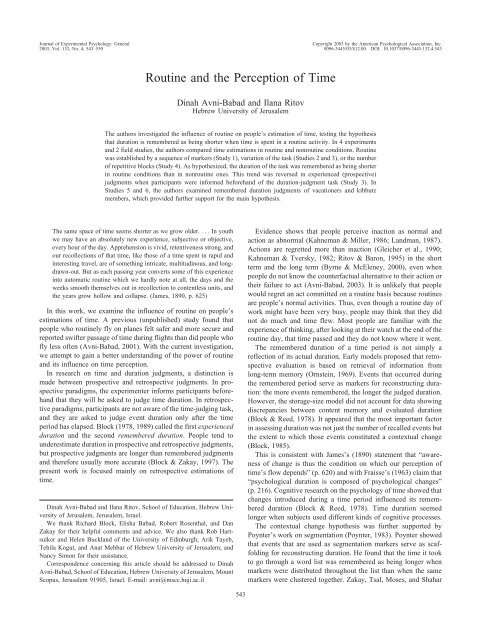
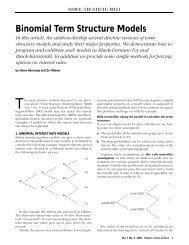
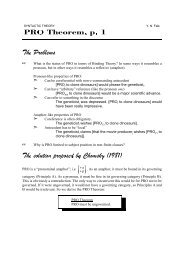
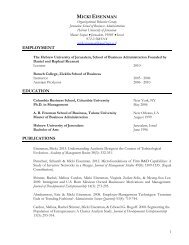
![CV [PDF] - Pluto Huji Ac Il](https://img.yumpu.com/18174585/1/190x245/cv-pdf-pluto-huji-ac-il.jpg?quality=85)

